
Context of the project
Company
LegalZoom's mission is to democratize law. Part of that democratization is enabling americans more affordable and accessible estate plans. Estate planning allows customers to protect their families, loved ones, and what they have worked so hard for. Thereby creating peace of mind.
Business opportunity
Estate planning every year contributes tens of millions to LegalZoom's revenue, yet the total addressable market for estate planning services each year in the U.S. is $5 billion. As more of the estate planning market transitions online, LegalZoom has the opportunity as market leader to move from tens of millions to billions in annual revenue.
Goal of the project
Re-imagine the product experience for estate planning to ensure 20% more customers who start their estate plan process finish. Start with the last will document (most popular) before moving onto the other products.
Customer problem
As a potential customer of LegalZoom I am trying to create a legally binding last will for me, my family, and my loved ones. However, the process is long and complex because the experience does not frame the process in an approachable and simple manner, and I am left on my own to make the right decisions. Which makes me feel overwhelmed and confused. And as a result I may give up all together or go somewhere else that makes the process more efficient for me.
Role & Responsibilites
Lead Product Designer. Responsible for end-to-end product design, defining over-arching product strategy with Consumer segment lead and Product Manager, User experience research and analysis, as well implementing and releasing design with Technology Lead and engineering team.
But before we fully dive in, let's talk constraints.
Or to put it another way, what allowed us to narrow our focus.
3 months
Our goal was to take the current web application for building estate plans, and use a 3 month roadmap to successfully address the project goal.
Data
Our data constraint was twofold. During our engineering process we did not attempt to re-design our data architecture given the time constraint. And second, our depth of data anlysis was constrained by how robust our database and reporting on the software is.
Documents
When all is said and done, the estate plan documents generated by the application inputs needed to yield the same minimum viable outputs for our legal fulfillment team who sends them to customers.
Overview of the project
A brief look at how we kept customers and solving their problems at the heart of the design
Research and define
Gain deeper understanding on the customer and the problems they are facing. This included data anlysis, surveys, customer interviews, creating personas for customers, and crafting journey maps for the customer.
Ideate & test
Using our research, create concepts that can address the customer's paint points, and offer solutions to their needs. And then put those concepts in front of potential customers rapidly.
Design & Results
We designed a product experience that successfully addresses customer problems, and verified those solutions at a large scale to decrease risk of full-scale rollout.
Challenges & Next steps
We will discuss what challenges the team overcame, and now that we have an understanding of customer reaction, we have a focused set of next steps.
Research
During the first phase of the project we used a variety of research methods to understand the customer, detail their pain points, and identify opportunities to create innovate solutions for our customers.
Analyze our quantitative data and customer behavior
Using Quantum Metric, Google Analytics, and Tableau we analyzed key metrics for the current customer experience.
One key takeaway from our data analysis was that there are is far too much interaction cost to the user to complete their estate plan. In a 30 day sample, session time to complete an estate was 45 minutes.

Customer Interviews & Transcripts
We conducted dozens of customer interviews to understand what customer's motivations were for starting an estate plan and where they experienced pain points. As well as thousands of customer transcripts. Both of these methods allowed us to synthesize our understanding of Who, What, Where, When, Why, and How
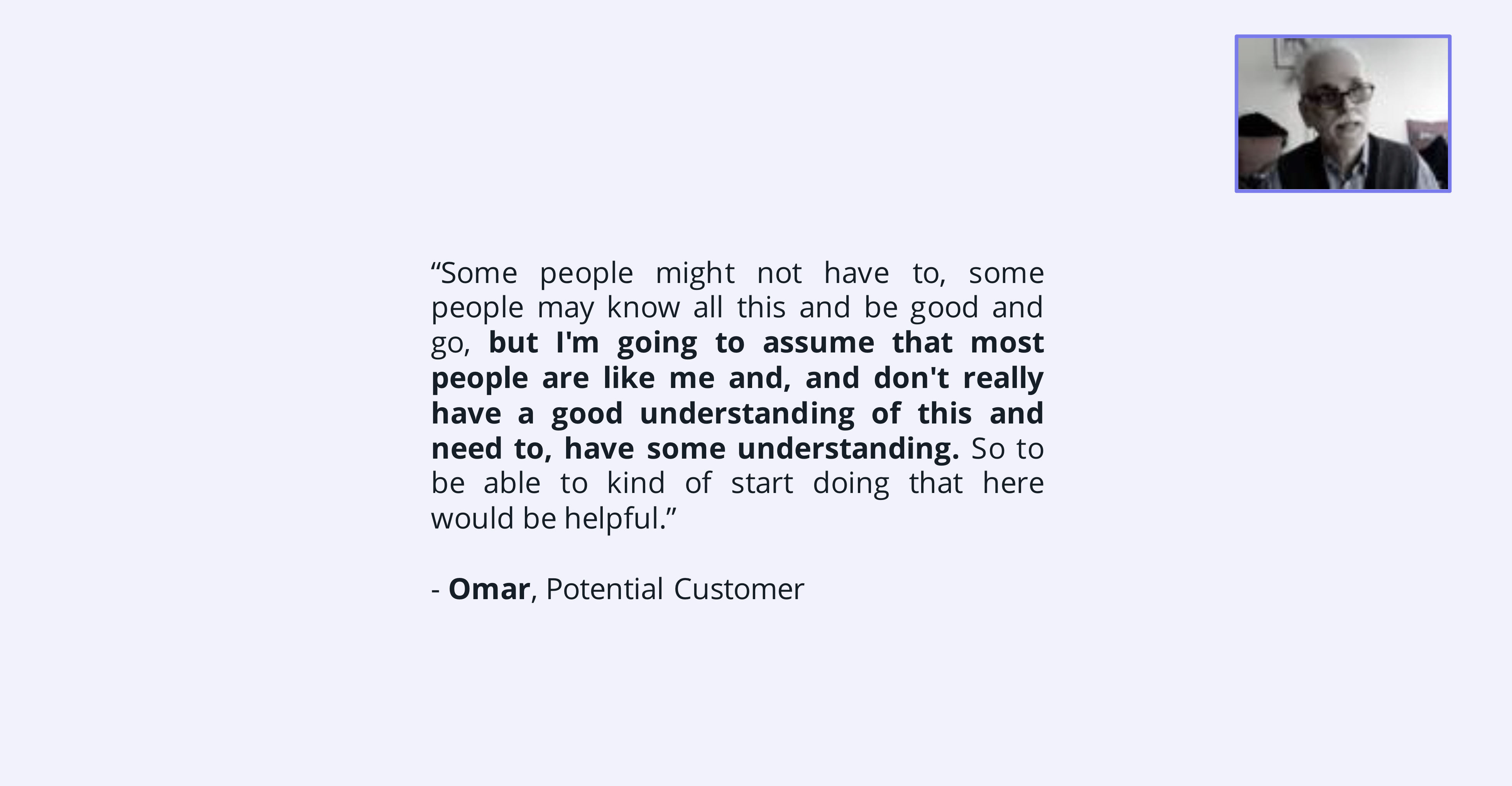
Market Surveys
With our marketing insights team, we looked into what solutions are customers looking for, what key variables factor into the decision to form an estate plan. And what are the motivational triggers to seeking out an estate plan.

Journey mapping
Using customer interviews we mapped out the various stages of the customer journey, so we can understand where this experience falls in their broader experience. As well as chart pain points inside the planning and awaiting phases.
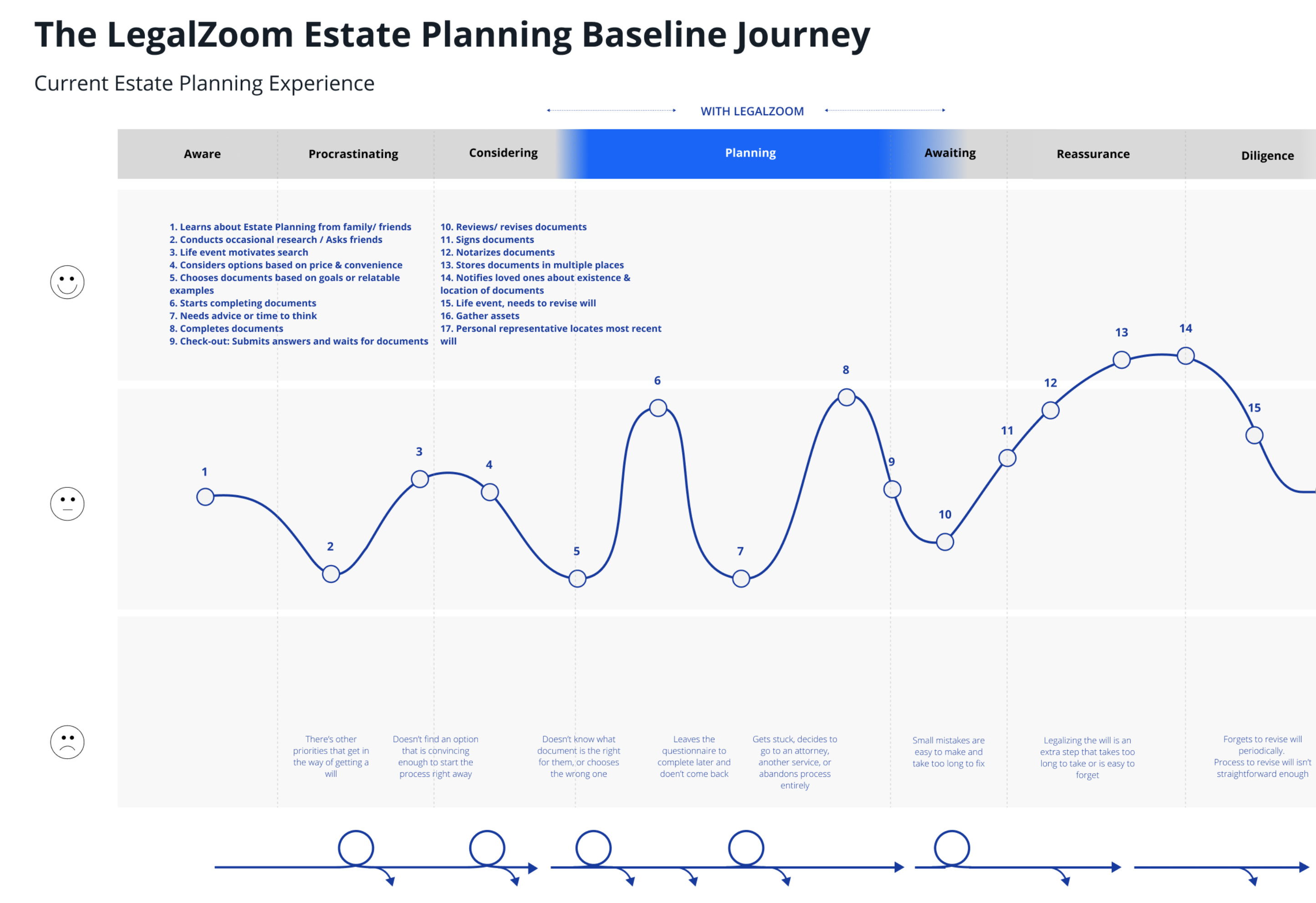
Competitive analysis
To understand how other companies in the space are solving problems for their customers, and to understand what innovations are possible, we looked at top competitor experiences in the field, as well as outside the industry.
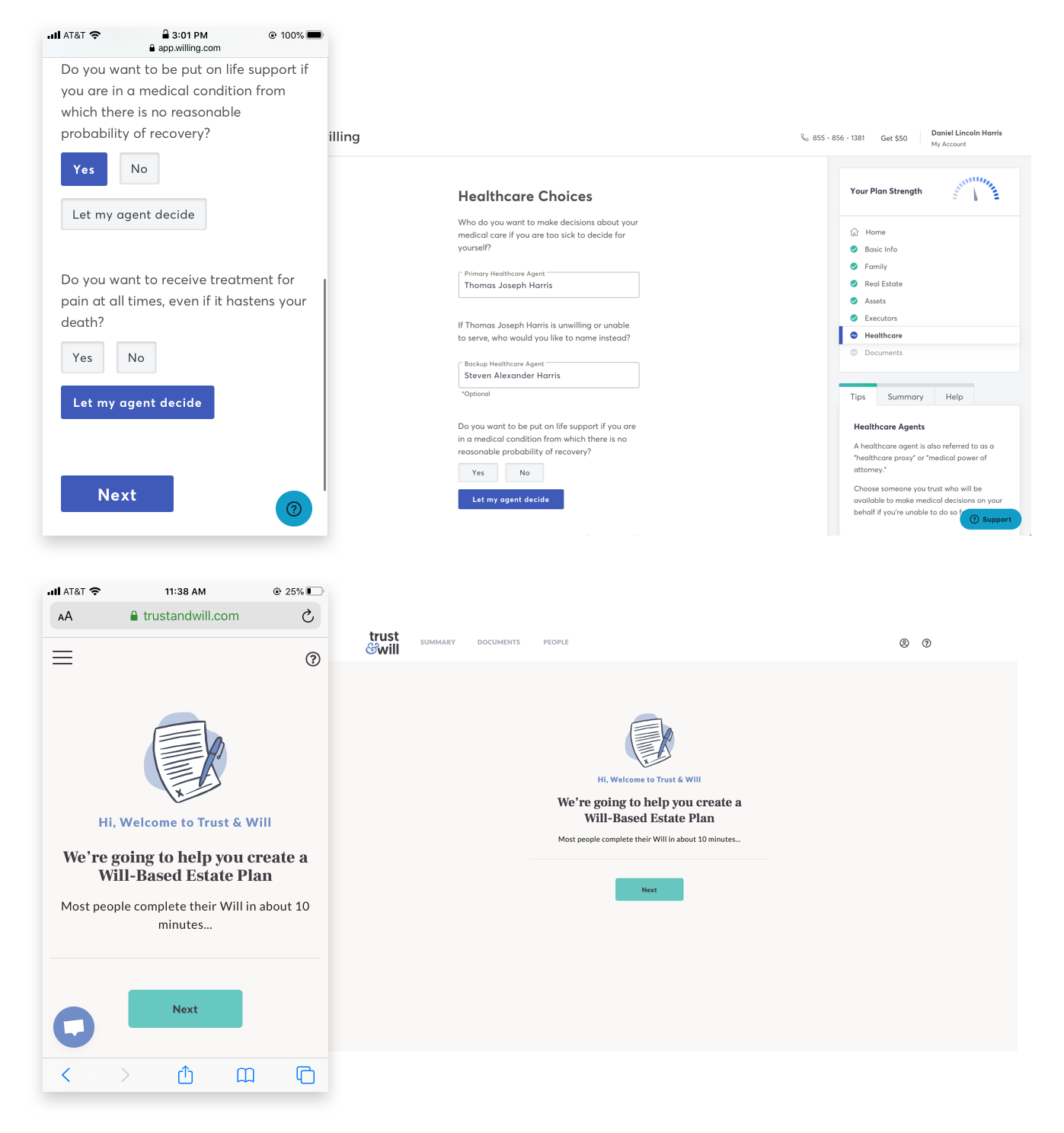
What we learned about our customers
Why
Estate planning is important for our customers because first and foremost it offers them peace of mind that their families and/or loved ones will be taken care of in the ways that they wish.
Who
Our estate plan customers are americans who range between the ages of 25 to 64. With the largest 2 cohorts being 35-44 and 55-64. 77% of our customers have families, and 54% own a home. Customers come from all ranges of occupation, though those who travel or work in dangerous professions are more likely to create an estate plan.
What
People are coming to us to create an affordable and simple estate plan online, given one the alternatives is offline with an attorney for 5 to 10x the price. In their eyes this means a legally-binding online document. Within the broader what of creating a final legally-binding document, there are ultimately a series of important decisions the customer has to make.
Where
The majority of customers complete this at home for 2 primary reasons. One, they often require discussing how to answer questions with their partner/spouse, or their loved ones. And two, our existing mobile experience as well as complexity of process makes this a barrier to complete on-the-go.
When
Our customers want to finish their estate plan quickly. Less than 15 minutes is ideal. They want to finish in one session, but through our research we found it often took multiple sessions to complete a document. Some customers take up to a year to to decide which document is right for them before starting.
How
Customers complete their estate plan using external research and talking to their family/friends to help reach a decision on a difficult question. Customers also lean on our customer support for questions on how to answer a certain question.
Our research yielded 3 key customer problems
Through our various methods of research 3 themes kept reoccuring, customers were overhwelmed by complexity, they didn't have confidence in their decisions and they didn't know how to get in contact with with experts who could answer their questions.
Complexity
In our research with customers, the difficulty and complexity at every step in the process was overwhelming and causing abandonment.
Confidence
Complexity of the legal process, from beginning to end creates a lack of confidence in which product to purchase, how to most accurately answer for their situation, and confidence that their document will be legally-binding.
Finding expert help
When customers have run into questions during their journey, they do not know where to turn to get answers from trusted sources. They are often left on their own to find answers to their questions.
Ideating to address customer problems
Map out current software's functionality
Why? The primary goal was to understand what legal outputs in the finished estate plan document were created by the customer's inputs. Given that we had the constraint to still produce legally-binding documents that our fulfillment team could deliver, it was essential to understand how the broader mechanisms worked.
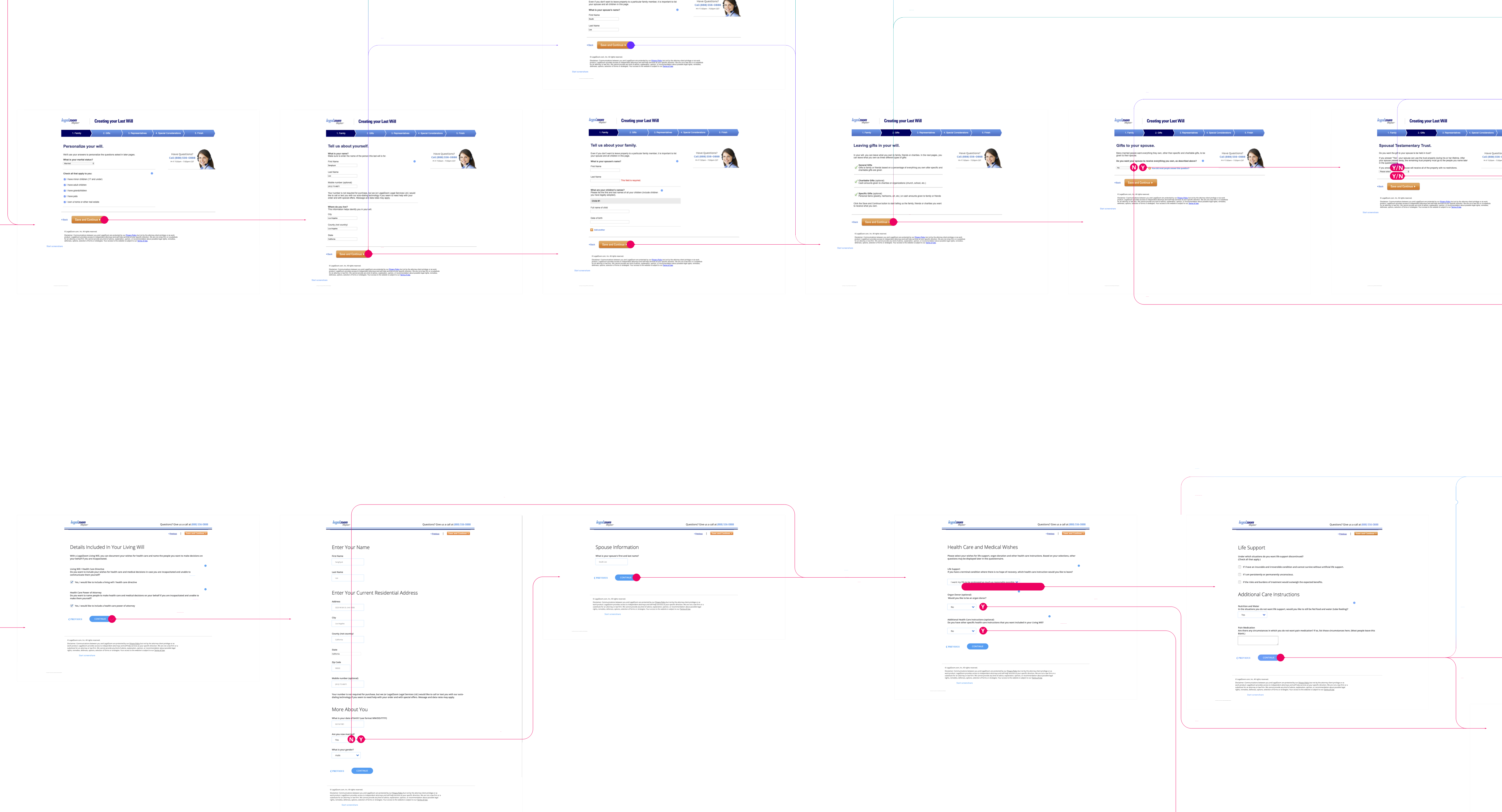
Sketching solutions to customer problems
Why: To ideate rapidly with cross-functional teamates and to allow our team to get feedback from company leadership, as well other segment leaders. Lastly, it allowed us to start with more broad, holistic solutions before narrowing down.

Mapping the user journey
Why? To allow the engineering team to run in parrallel with a hackathon to create a new application architecture that was more flexible and intelligent based on customer inputs. Allowing product and design at the same time, to test some our riskiest user-centric assumptions.
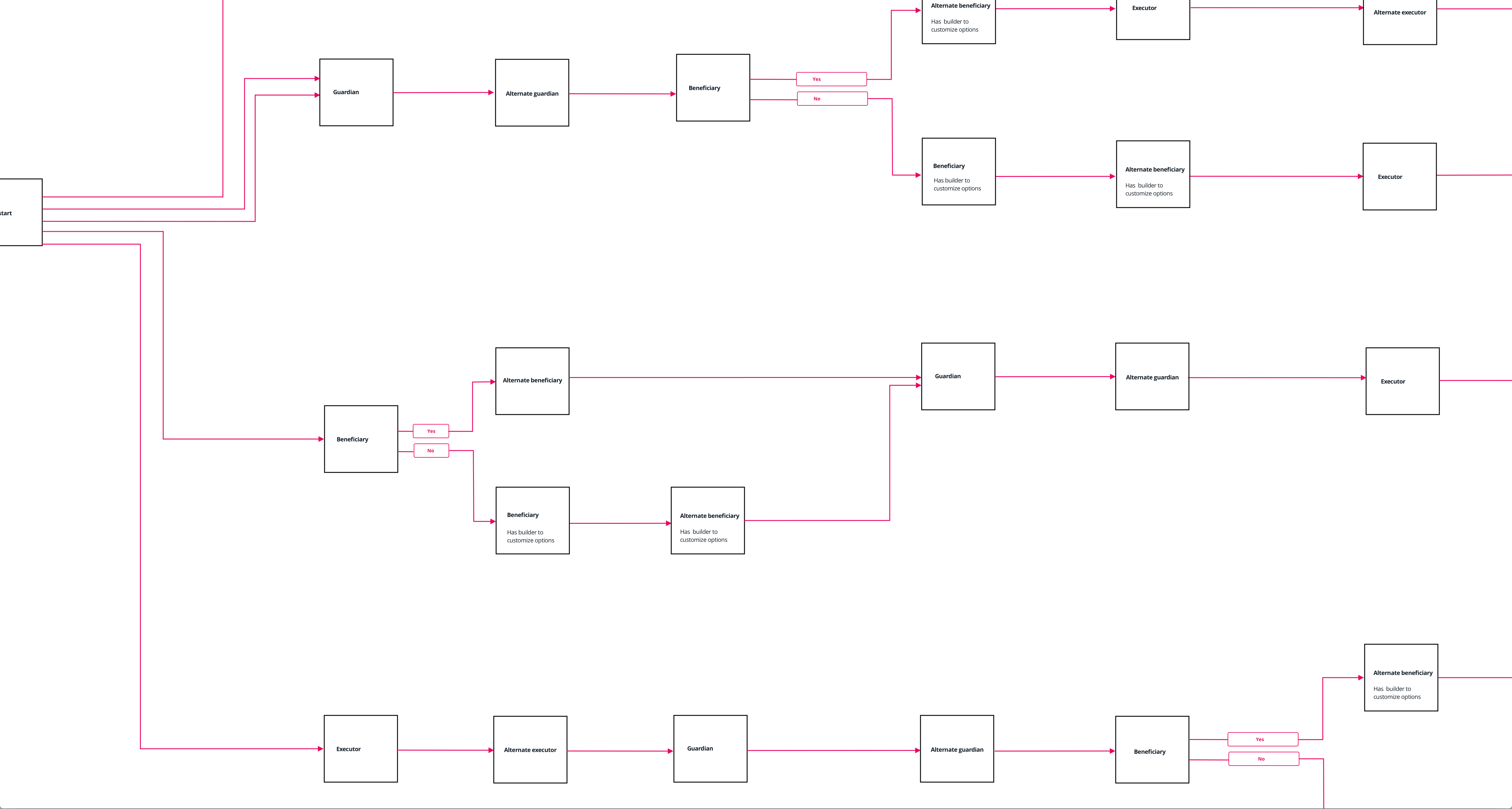
Key solutions to validate with customers
Though there were a large set of clear improvements to make in terms of accessibility, functionality, decreasing interaction cost, and simpicity of the process, there were 3 risky assumptions that we wanted to test separately with customers. Each of these assumptions were grounded in solving explicit customer problems from our research.
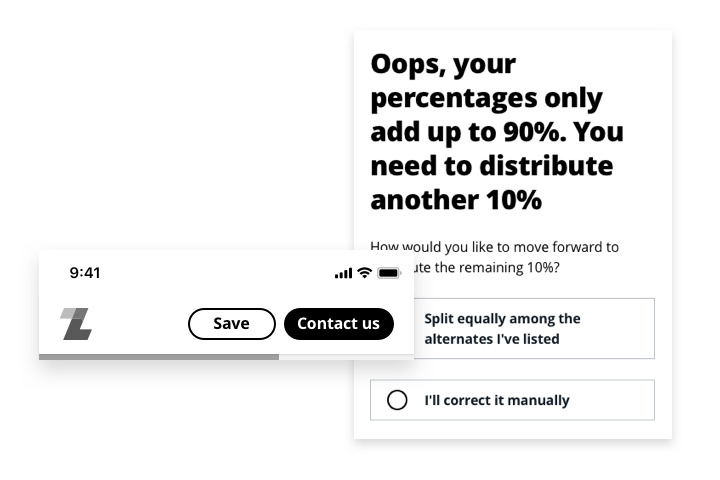
Simple expectations. Obvious feedback.
In order to decrease perceived complexity, throughout the customer experience we set expectations on time, how far along they were, what was coming next, and when they finished a set of work so they could save and exit as needed.
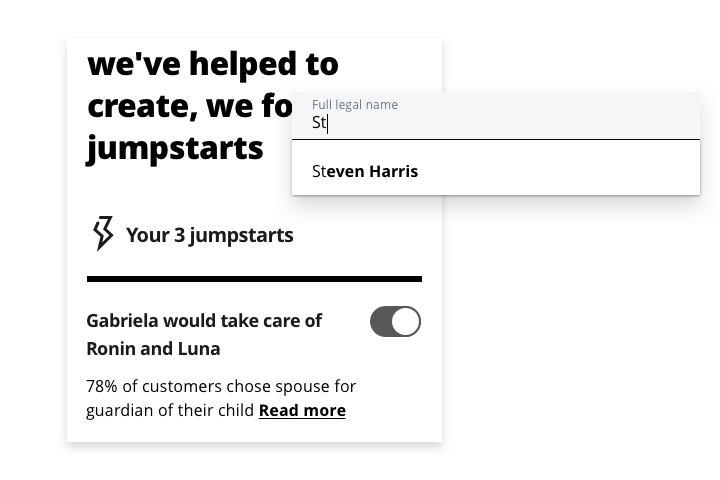
Think & do for the customer
When possible, we will make recommendations, automate easy tasks, and go the extra mile to do some thinking on the customer's behalf. We will leverage our data on previously completed estate plans. All with the goal to simplify and expidite the experience and reduce friction.

Expert help along the way
One of our strongest value propositions at LegalZoom is a nation-wide network of vetted attorneys. But customer's previously had no way to leverage their expertise. So we took steps towards the longer-term LegalZoom goal of embedding legal experts in our software.
Rapidly testing assumptions with customers
We used a high fidelity interactive prototype with invision to test how our assumptions on key alleviators of pain points would address the customer's perception of complexity. And whether they would actually find our solutions valuable in their process to create a last will.

Designing & Implementing
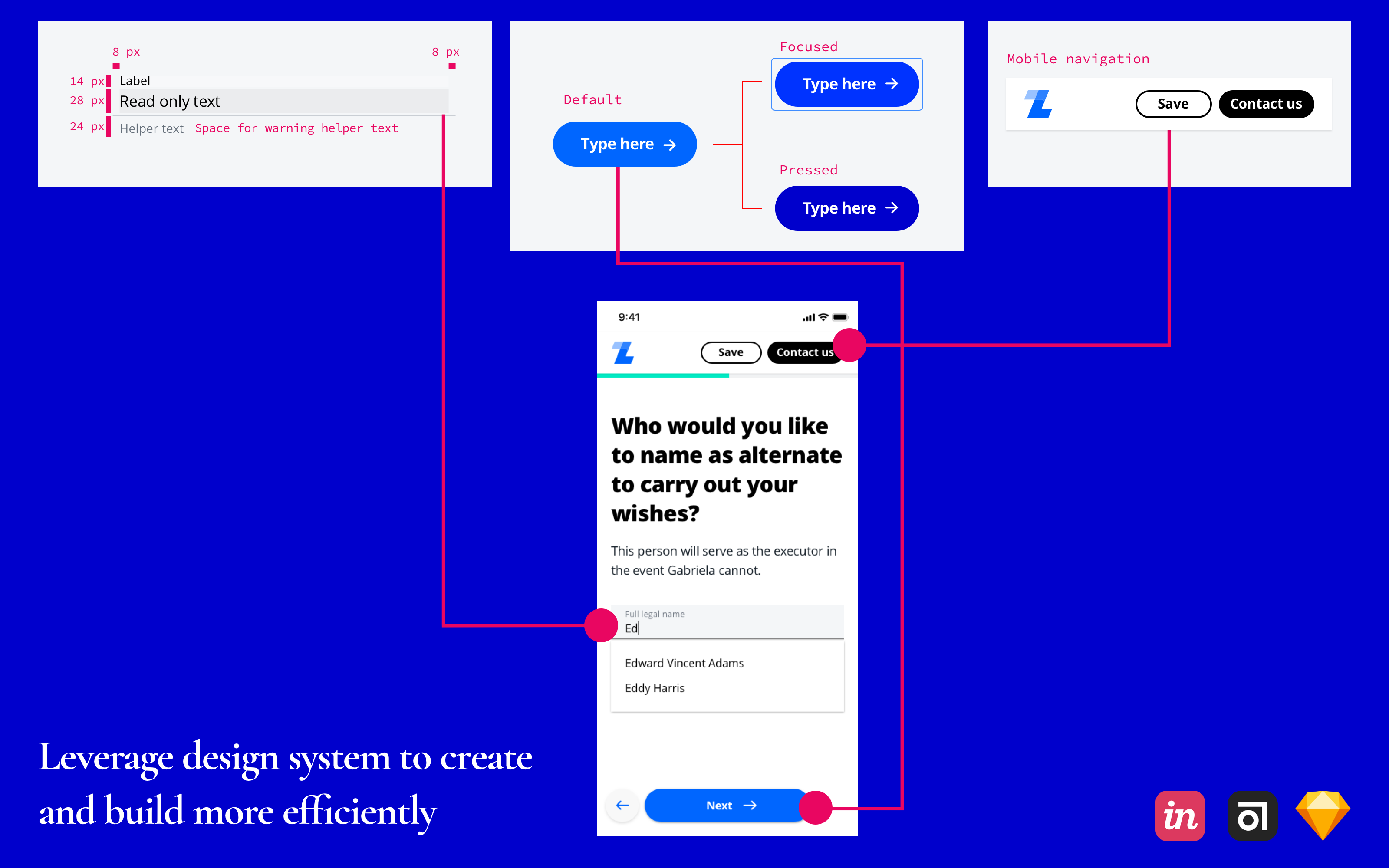

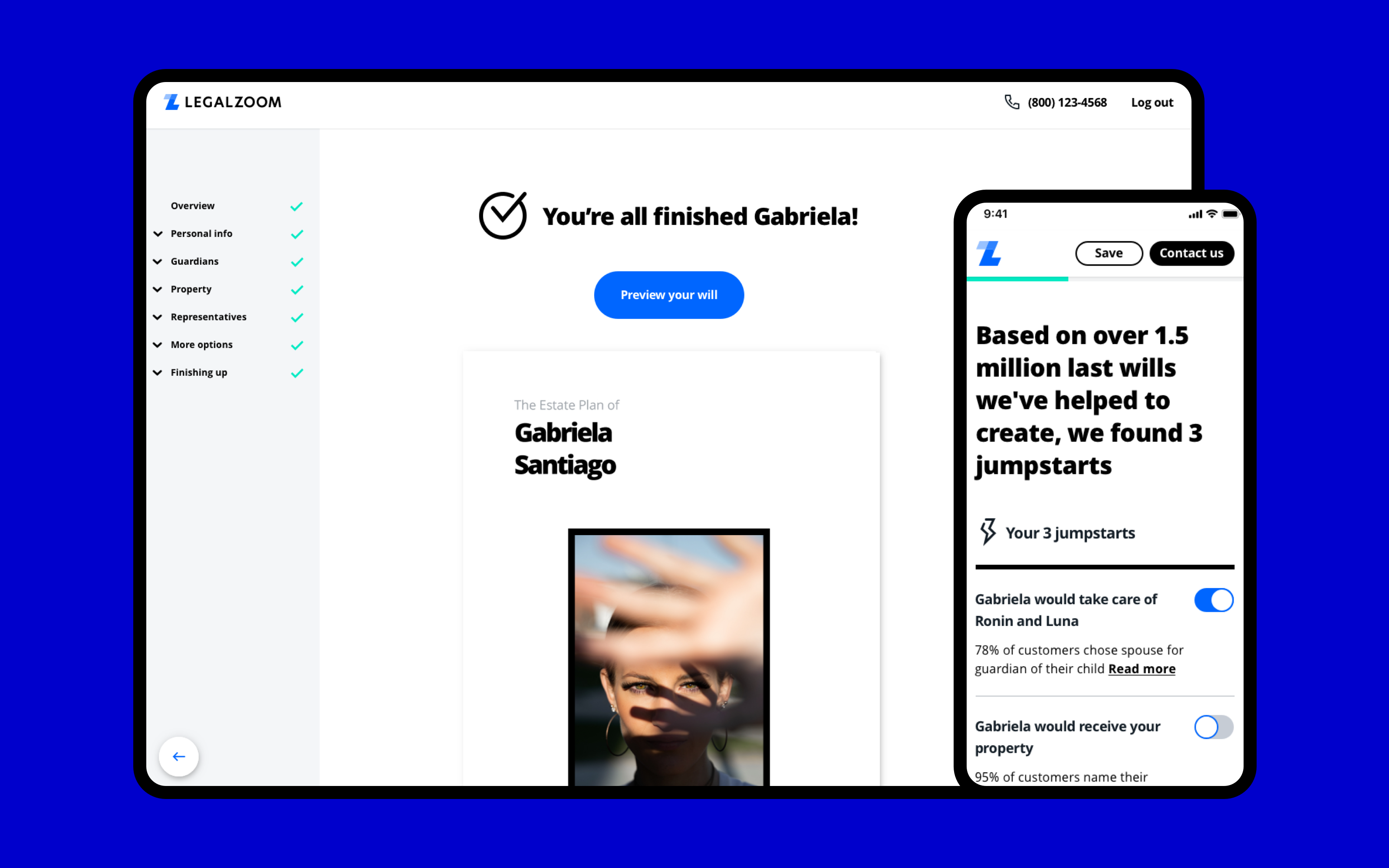
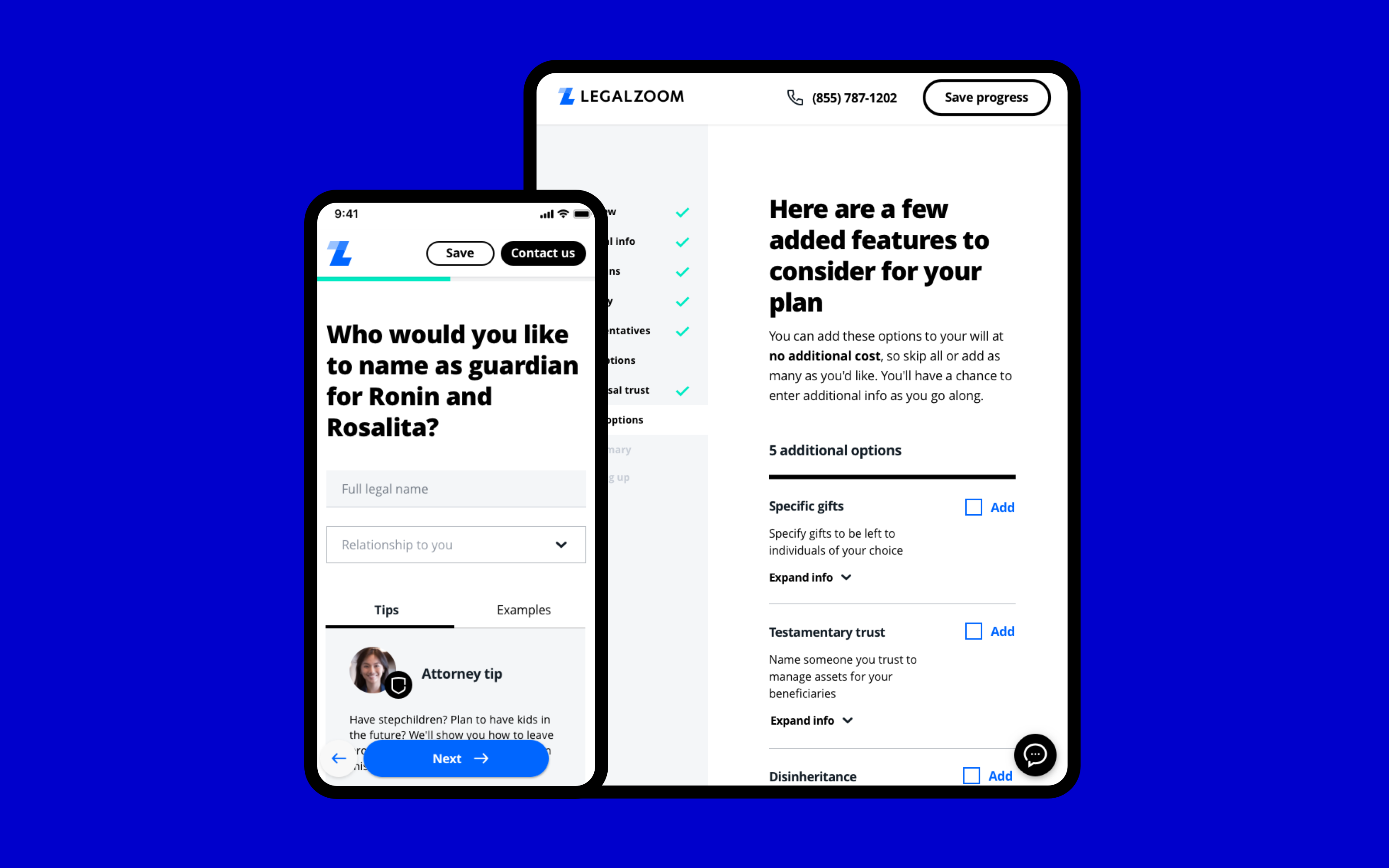
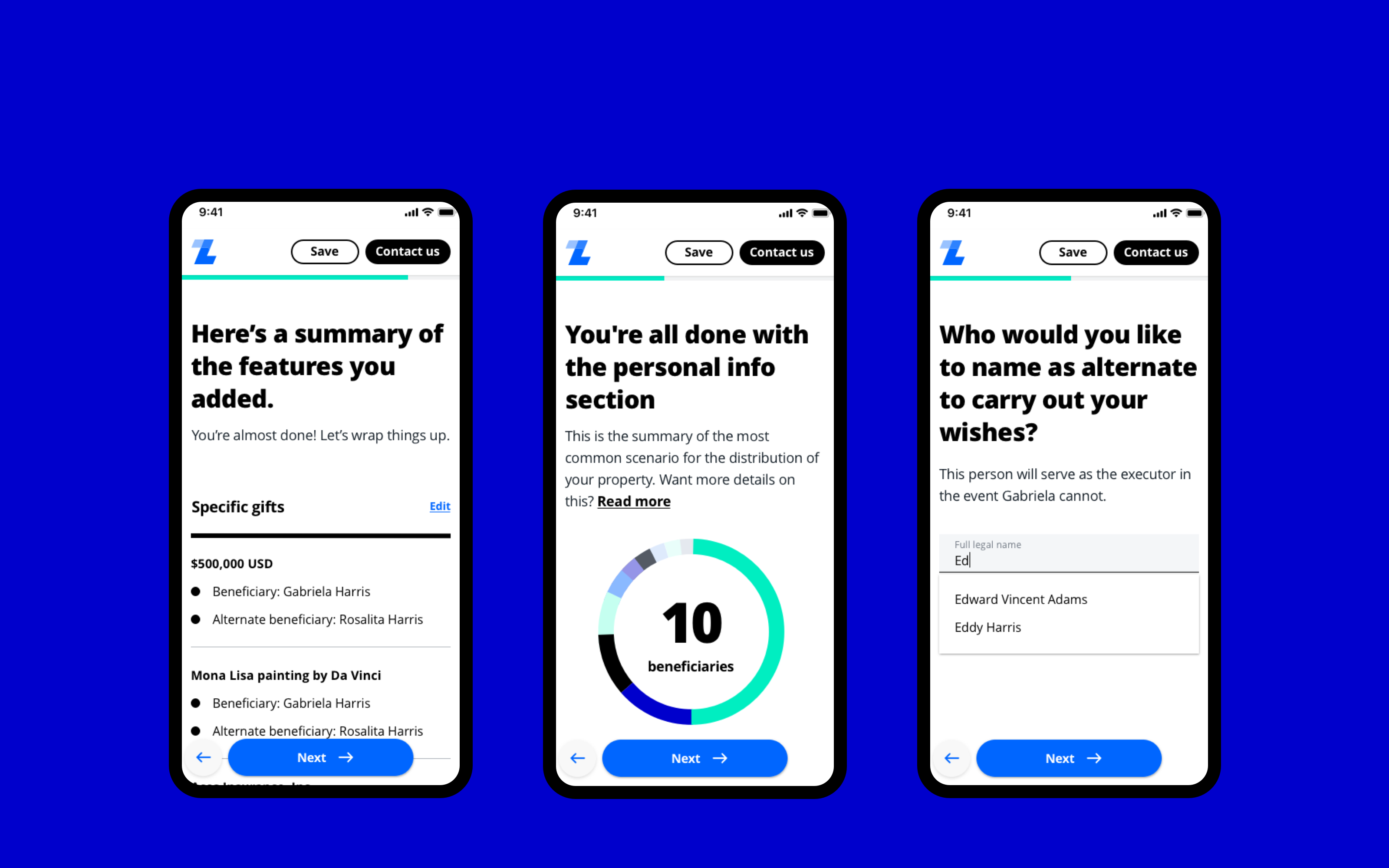

Results
Using an 50/50 split in our production environment, with a sample size of 100, we had users complete their last will in the legacy experienc and the re-imagined experience. The primary goal was to understand key metrics on time to complete, completion rate of tasks and NPS scores between the two experiences.
Increase in task completion rate
Respondents were more likely to be highly confident that they completed given tasks throughout the test when compared to the legacy experience.
Decrease in session time
A core metric to our hypothesis was session time. Because of the way we re-architectured the software respondents were able to finish their last will creation in a shorter time window when compared to legacy experience
Proliferation of solutions
Because our results were so positive the C-team of LegalZoom, and other segment leaders quickly acted to implement aspects of this product experience in other segments.
Challenges & Next Steps
What we overcame as a team and where we are going next.
Challenges
1
Timeline
With a single engineering team the 3 month timeline was our single biggest challenge. So we re-prioritized as needed each week to ensure the critical requirements were ready at the end of month 3.
2
Focus
Because so much of LegalZoom's revenue comes from business formation products relative to estate planning product, it was a challenge for the project to keep capital expenditure focus. And so we communicated on a regular basis the success along the way, to influence leadership to continue to fund until the stated project end-date.
3
Robust datasets
A constraint and challengage throughout because of the underlying technology (read very old) limitations of the software was access to robust and cleaned dataset. To overcome this, we stayed focused on the most critical quantitative and qualitative data and research to inform our decisions.
Next steps
QA Fulillment of Documents
The team needs to test whether the software inputs are creating the correct outputs for the legal documents.
Tie into checkout
The web application now needs to be connected to order checkout.
Testing at scale
Dedicate a small subset of live traffic to the new product experience once the prior two steps are finished.
Thanks for your time - Dan
